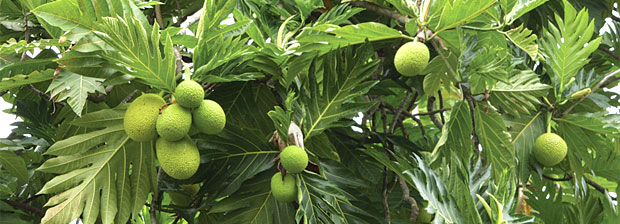Easy to grow. Produces an abundance of nutritious fruit. Begins bearing in 2-3 years and is productive for decades. Breadfruit has all of these advantages and more.
[wp_ad_camp_1]
The fruit belongs to a tropical tree originally from Papua New Guinea and has been grown in the Pacific for 3000 years. Breadfruit is unlike any other fruit you've eaten before. That's because breadfruit does not have the look, feel or consistency of a typical fruit, but like its name suggests, looks much like bread. When the breadfruit is ripe, it is relatively soft and the inside has a yellow, cream colored flesh that resembles bread. The flesh of the breadfruit is somewhat sweet and has a nice fragrant smell.
Binomially, the fruit belongs to the family of Moraceae, of the genus Artocarpus. Scientific name is Artocarpus altilis.
Breadfruit tree has many similarities to jackfruit in all respects except that the breadfruit arises out of the terminal ends of small branches; whereas jackfruit erupts directly from the trunk and large stems.
According to Dr. Diane Ragone, Director, Breadfruit Institute, this important staple crop can be the most important food of the future. "For the first time in history, we have a potentially permanent solution to hunger in tropical regions" she adds.
[wp_ad_camp_2]

Health Benefits
1. As in other tropical fruits, breadfruit comes with lots of calories; 100 g fresh fruit gives 102 calories. The major fraction of this comes from carbohydrates.
2. Its pulp has more fiber than jackfruit, which makes it a good bulk laxative. Dietary fiber helps reduce blood cholesterol by preventing its absorption in the gut. The kind of fiber in breadfruit actually lowers the LDL levels (the "bad" cholesterol) while raising the levels of the HDL (the "good" cholesterol) which protects the arteries.
3. It helps protect the colon mucous membrane by warding off cancer-causing chemicals from the colon. Also makes the intestines and bowels work properly by clearing out the junk from the intestines.
4. Prevents cancer. In addition to protecting the heart, leaf of breadfruit is shown to prevent inflammation. Various sources mention breadfruit leaves having anti-inflammatory properties.
5. It has small amounts of flavonoid anti-oxidants in the form of xanthin and luein. Yellow-orange varieties have more of these compounds.
6. Breadfruit has more vitamin C than jackfruit and banana, provides about 29 mg or 48% of RDA. Vitamin C (ascorbic acid) is a strong water-soluble antioxidant. Consumption of fruits rich in the vitamin C help body develops resistance against infectious agents and scavenges harmful free radicals.
7. The dried fruit has been made into flour which is much richer than wheat flour.
8. Fiber present in breadfruit helps those with diabetes to control the disease to some extent by reducing the absorption of glucose from the taken food. It is also believed to reduce asthma. Toasted flowers of the breadfruit tree are also rubbed on the gums as a cure for tooth ache.
9. Fresh fruit is an excellent source of potassium. Potassium is an important component of cell and body fluids that help regulate heart rate and blood pressure. Its pulp is good in copper, iron, magnesium, and phosphorus.
10. Breadfruit seeds contain adequate levels of protein; 100 g seeds provide 7.4 g or 13% of daily-recommended values. However, they are excellent sources of minerals like potassium, iron, calcium, zinc, selenium, manganese, etc.
11. Breadfruit contains a good amount of omega-3 and omega-6 fatty acids. These fatty acids are very important and help the body and mind to develop normally. These fatty acids also hasten and stimulate skin and hair growth, regulate our metabolism, promote reproduction and stimulate bone growth and health.

Some Serving Tips
Raw breadfruit cubes can be added in stews, soups, baking, and stir-fries much like potatoes.
Its slices can be fried and eaten like French fries. Thin slices can be made into chips.
Fresh ripe fruit is eaten much like dessert. It can be added to make sweet bread, muffins, cakes, puddings, etc.
Its seeds are gathered, sun-dried, and used much like other nuts and kernels.
Breadfruit's proponents say it has unique qualities that could popularize it in the future. One tree can produce 450 pounds of fruit per season. The fruit is rich in fiber, potassium, phosphorous, calcium, copper, and other nutrients. Its texture and yeasty odor remind some people of fresh bread.
[wp_ad_camp_3]
Image courtesy: blogspot.com , esri.com , nairaland.com


No comments:
Post a Comment